Magnificently quirky and characterful, the little owl is Britain’s smallest owl at 22cm tall with a 56cm wingspan. Unlike the other four species of owl which are resident in the UK and British Isles (barn, tawny, short-eared and long-eared), the little owl is actually not a native species, and was introduced in the late 1800s, with the first successful releases in Kent and Northamptonshire.
Adult little owls can make over 20 different vocalisations, which can resonate several kilometres on a still night. Undulating flight means little owls are often mistaken for mistle thrushes and green woodpeckers, which are of similar size and, like the owls, often occur in farmland and open grassy areas.
Read on to learn more about this species in our expert guide by Dr Emily Joáchim from the UK Little Owl Project:
What is the scientific name of the little owl?
The scientific name of the little owl is Athene noctua and was given by given by Italian ornithologist Giovanni Antonio Scopoli in 1769. It is the only resident species belonging to the Athene genus, which takes its name from the Greek goddess Athena, who is a goddess of the night and often pictured with owls.
The ancient Greeks, hypnotised by the little owl's gaze, ascribed to it great powers. Turn over any silver coin from Plato’s era and you will find its saucer-eyed image (the flip side depicts Athene).
Other species in the Athene genus around the world include the spotted owlet (A. brama), burrowing owl (A. cunicularia), and white-browed owl (A. superciliaris).
How to identify little owls
Male and female little owls look similar in size and plumage. They have a stocky silhouette due to their broad, round head and body, and short tail. Chocolate-brown in colour with an olive-brown tinge, little owls have cream-buff streaks and spots on their body, wings and head. Tarsi are cream-buff and their talons are brown. Markings on the back of a little owl’s head are similar to those on the front, an adaptation to deter ambush attacks by other owls and sparrowhawks.
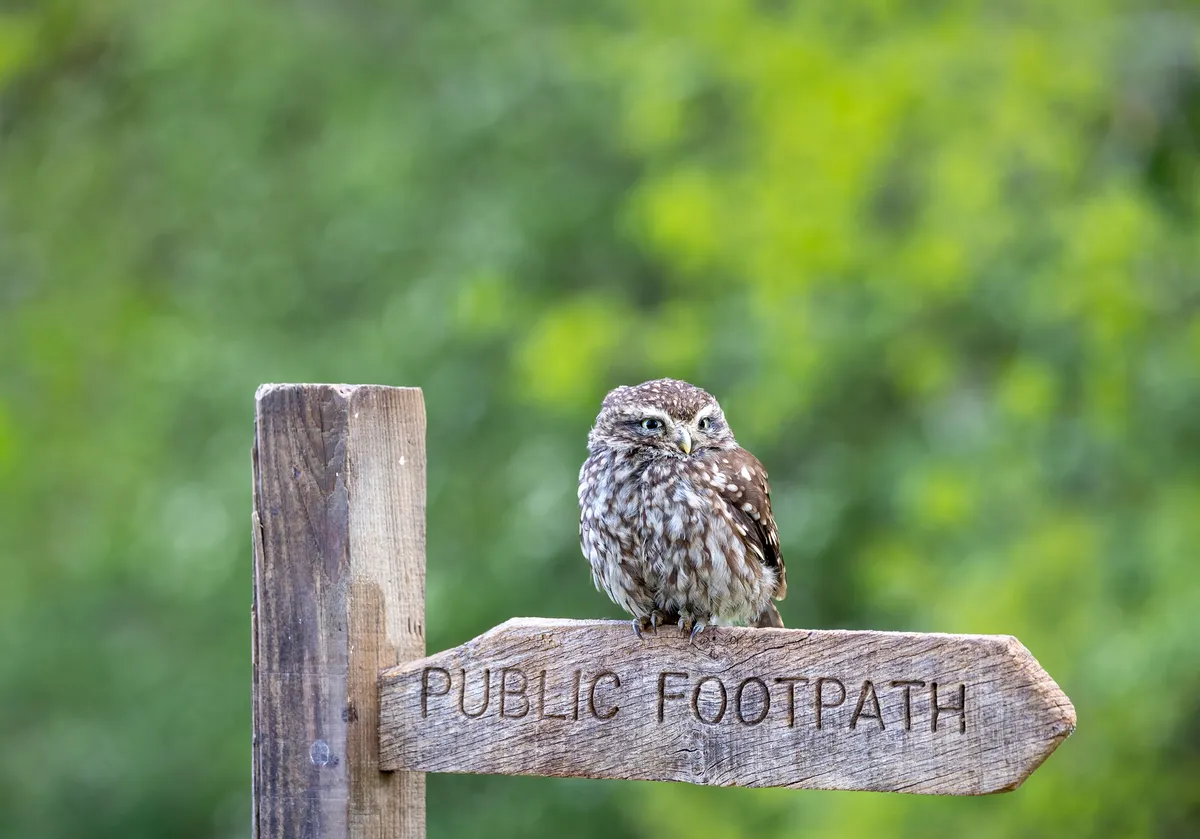
Adults have lemon-yellow iris and pale feathers around their eyes, giving them their characteristic frowning expression. Juvenile iris colour is pale yellow-grey and this turns to lemon-yellow at three months old.
The little owl’s flight is a series of fast wing beats and looping glides.
What do little owls sound like?
The little owl is a vocal species and can make over 20 different vocalisations including their shrill and repetitive ‘goooek, goooek’ and ‘kweew, kweew’ sounding calls. Some say they sound like a mewing cat.
Male and female little owls make regular contact calls with each other. You can hear them throughout the year but they are most vocal during the breeding season. Juvenile little owls make a hissing sound when begging for food. This is higher pitched than juvenile barn owl hissing sounds.
What do little owls eat?
The little owl is an opportunistic predator. It predominantly eats invertebrates throughout the year, predating the most dominant species at any given time. Earwigs are the most taken insects, followed by black clock beetles, rove beetles, weevils, click beetles, dor beetles, crane flies and cockchafers.
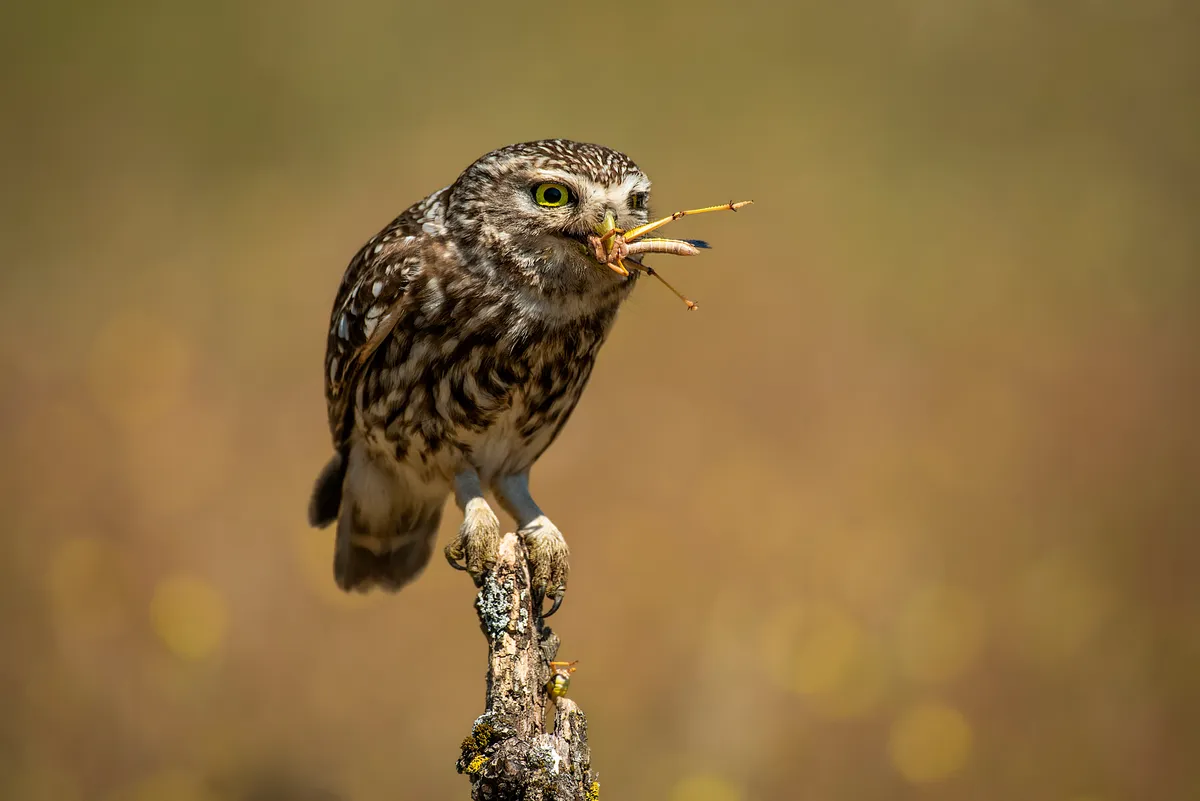
Spiders, moths (larvae and adults), millipedes, centipedes and ants are also frequently predated and it is not uncommon to find an active nest site full of live earthworms to be fed to the young owlets. When a shower starts, little owls can quickly switch to earthworms, and continue to bring these to the nest as long as it rains.
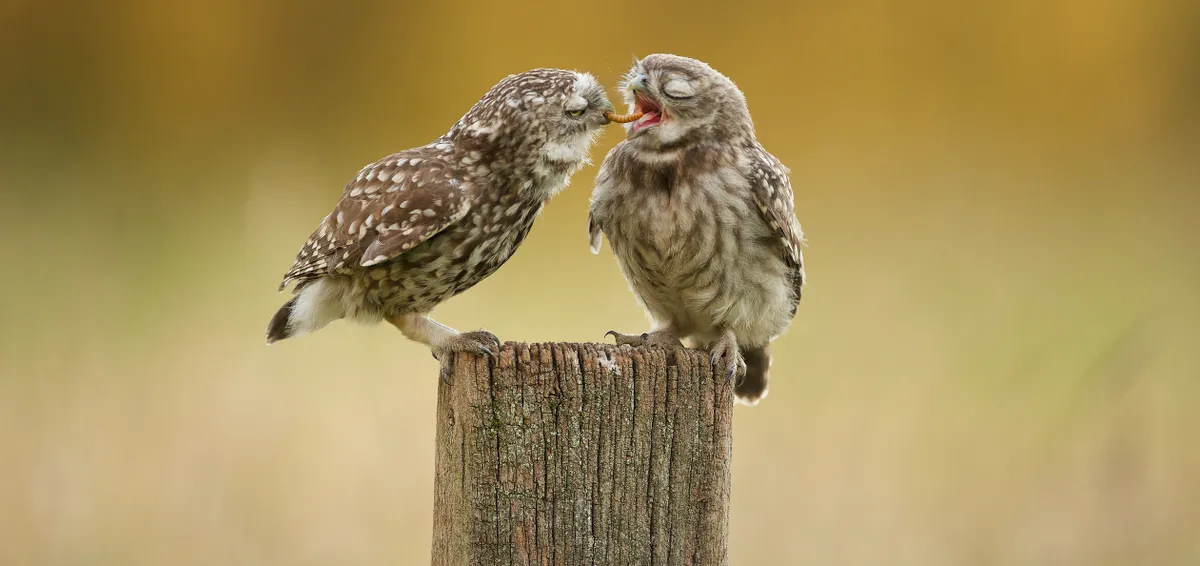
The little owl will also predate small mammals (particularly voles) and birds (sparrows and starlings), especially during the breeding season. Diet often varies between breeding sites and in different months and years depending on what is available. The species is also capable of tackling young rabbits its own weight: when its talons lock on, they won't let go.
How and when do little owls hunt?
With a relatively wide diet, their approach to hunting depends on prey availability.
Little owls have excellent eyesight. Their retina has lots of rod cells for night vision, and enough cone cells for vision in daylight. This enables them to hunt in daytime as well as in darkness. They often hunt from a perch, such as a fence post or branch, and they pounce on their prey.
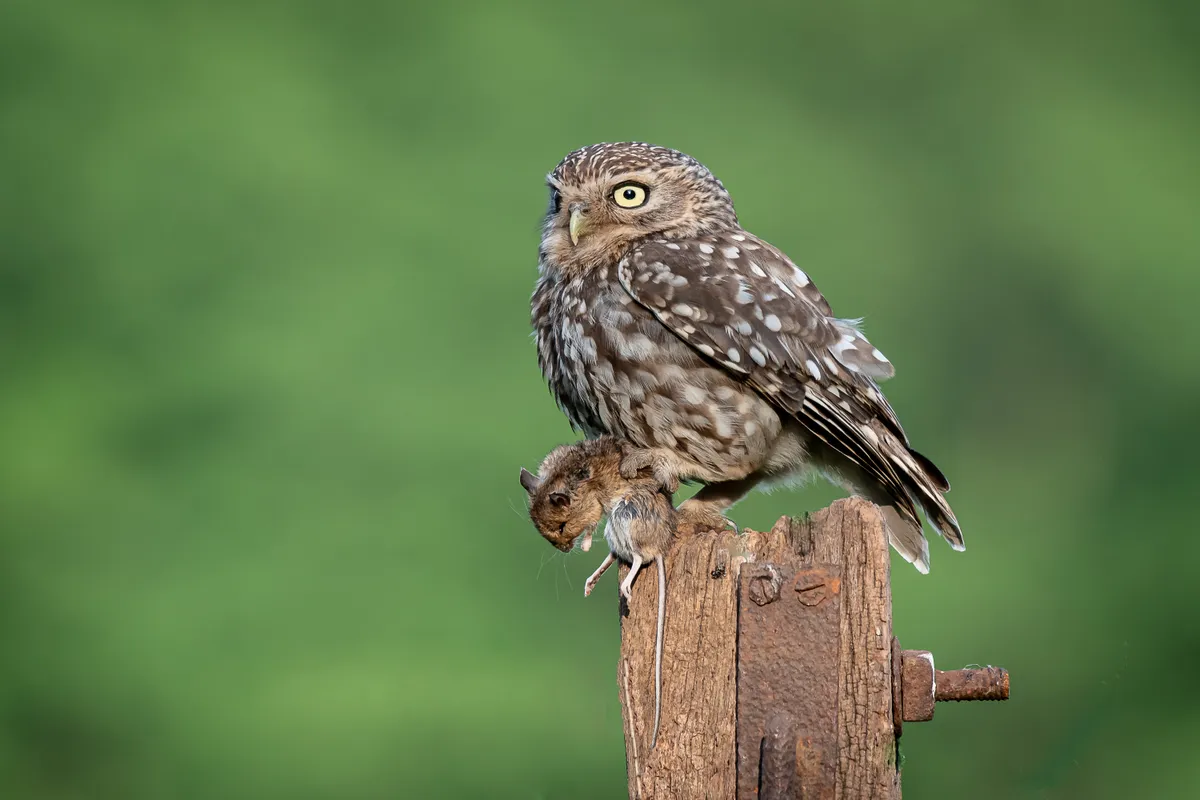
They can also be seen running along the ground in pursuit of ground beetles and small mammals.
They also possess excellent hearing and can locate the rustles and squeaks of mice and voles with an accuracy of up to 99%.
Late spring and summer are the best times to try and see a little owl. Shorter nights and the need to satisfy a growing family back at the nest make the adults more visible than in any other season. The gloomy couple of hours after sunset and before sunrise are peak foraging periods, but around Midsummer’s Day the voracious chicks are so demanding that their parents sometimes appear in broad daylight.
What eats little owls?
The little owl itself is prey to rats, weasels and stoats, squirrels, foxes, badgers, other owls, buzzards, sparrowhawks and peregrine falcons.
Where do little owls nest and when do they breed?
Little owls nest in pre-existing cavities such as holes in old trees, building cavities, stone walls and in nest boxes. They don’t build a nest inside the cavity; they make a scrape in substrate for egg laying. Little owls are monogamous and established pairs occupy and defend their territory throughout the year.
They are creatures of habit and ‘home birds’ at heart. A pair will not stray far from its own small territory, defending it against invaders, and roost sites are used by successive generations. The more isolated or exposed the roost’s location, the better.
Little owls usually start egg laying from mid-April onwards. A prolonged cold or wet snap in late winter can delay breeding for some owls, whereas warm and dry weather can advance it. Three or four eggs are usually laid. In optimal conditions, a female can lay up to seven eggs. Little owl eggs are matt white. The female incubates the eggs for 29-31 days.

Once hatched, she continues to keep the chicks warm until they can thermoregulate at 14 days old. Both the male and female feed the owlets between dusk and dawn, sometimes in daytime too. Little owlets fledge after 3-4 weeks but remain close to their natal site until July or August.
Most little owls settle within 2km of their natal site. A third of juveniles are thought to survive fledging and winter to go onto breed the following spring. Typical lifespan is 3-5 years old.
Where can little owls be seen?
Little owls are resident birds and can be seen throughout the year. They can be found in England and Wales with a few pairs in Southern Scotland. They are more abundant in East Anglia, the Midlands and North West England.
Little owls live in a variety of habitats including lowland farmland, orchards, parkland, rural villages and quarries. Territories are made up of a patchwork of grassland, hedgerows, fences, tree lines, scrub and barns.
You can spot them in daytime perched on fence posts, barns, telegraph poles, tree pollards and chimney stacks. They are most active between dusk and dawn.
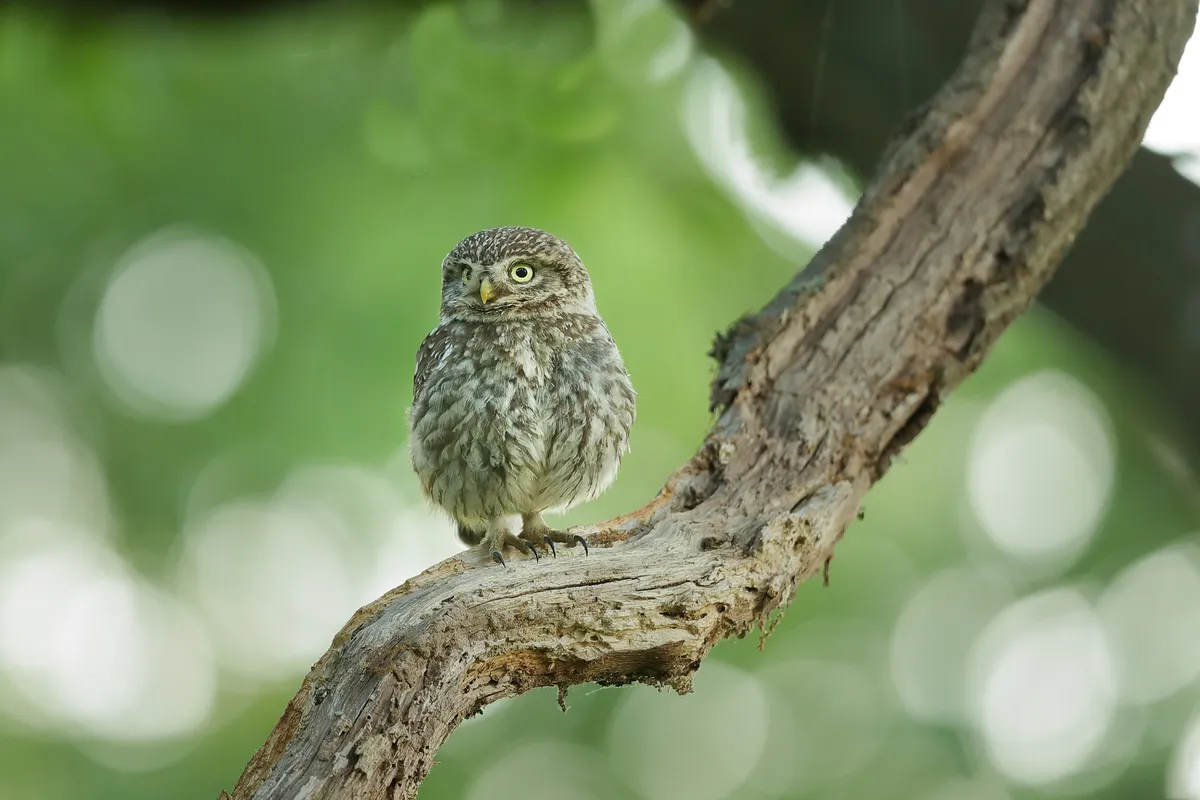
Is the little owl native to the UK and British Isles
In 1758, the first little owl was recorded in the British Isles. It was either a migrant from mainland Europe or an escapee from captivity.
Most of Britain’s little owls originate from introductions during the late 19th century. The first successful introduction was by Edmund Meade-Waldo in Stonewall Park, Kent - he released 40 owls between 1874 and 1880.
A pair first bred here in 1879. A second successful little owl introduction was carried out by Lord Lilford, near Oundle in Northamptonshire during the 1880s. A pair first bred here in 1889. Little owls are thought to have rapidly colonised England from both release sites. This was aided by further releases.
By 1940, the little owl had colonised much of England and Wales. A breeding pair was recorded in Southeast Scotland in 1958; less than 50 pairs have colonised Scotland.
What is the little owl’s population trend?
Britain’s little owl population is in rapid decline. Data generated from British Trust for Ornithology-led bird surveys indicate that it has declined by 58% over a 25 year period (1992-2017). There has been an 11% contraction in its range since Bird Atlas 1968-72; latest Bird Atlas maps highlight further losses in its breeding range in England and Wales.
Its current population size estimate is 3,700 breeding pairs. The little owl has declined in mainland Europe and it is listed as a Species of European Conservation Concern. Habitat changes due to intensive agricultural practices is thought to be driving its decline in Europe.
How do little owls cope in cold weather?
Fat reserves are proportionately greater than in barn owls, so little owls are better able to cope with cold weather. But prolonged snow is a major cause of mortality for both first-year owls and adults.
How can I help little owls?
You can help little owls by installing a nest box close to a sighting, reporting your sightings to the UK Little Owl Project and sending your nest records to the BTO.
Consider setting up a little owl conservation or survey project with your local bird group, working with landowners to help provide suitable breeding and foraging habitat for little owls.
Contact the UK Little Owl Project with little owl queries or to receive advice.
The UK Little Owl Project is dedicated to UK little owl research and conservation. The project aims to further our understanding of UK little owl ecology. It supports, develops and promotes new and existing UK little owl research and conservation projects.
The project was established by Dr Emily Joáchim in 2015 with the kind assistance of Andy Rouse Wildlife Photography.
Main image: A little owl perched on a derelict building in Suffolk, England, UK. © Gary Chalker/Getty Images